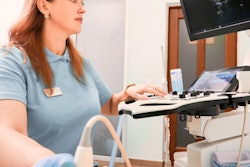
Teaching radiologists how to deliver bad news to patients is one of several key points from a survey study on training breast imagers published August 30 in Current Problems in Diagnostic Radiology.
Researchers led by Dr. Nicole Winkler from the University of Utah also found there is varied opinion on organizing breast rotations for screening, diagnostic, and procedural domains in breast imaging required in radiology residency.
"The vast majority of respondents support a mix of screening, diagnostics, and procedures across all three rotations," the study authors wrote.
While current breast education is comprehensive when it comes to guidance and residency programs, the study authors found little guidance on how to organize breast radiology rotations to maximize learning.
There are three domains when it comes to training: screening a high volume of normal studies with little-to-no patient interaction; diagnostic imaging, which has a high volume of abnormal and extensive patient interaction; and procedures, which requires technical skill and bedside manner.
The team created the survey to gather opinions of best practices from breast radiologists regarding resident training. The researchers wanted to assess perceptions of optimal breast imaging education from practicing breast radiologists.
A total of 109 responses were gathered. Out of these, 69 respondents worked in academic practice, 16 in private practice with residents, and 24 in private practice without residents. Forty-nine responders reported having more than 10 years of experience, while 60 had less than 10 years of experience. The team noted there was no significant variation in opinion for both groups.
About 90% of respondents (96) felt that residents should receive formal training on delivering bad news as part of their breast training. However, only 33% (36) respondents reported providing it.
Winkler told AuntMinnie.com that while most trainees participate in the delivery of good and bad news to patients while on their breast imaging rotations, a formal curriculum ensures all residents have standard training in the basics of patient-centered communication.
"Patient satisfaction is highest when we have a patient-centered approach to communication, including considering the environment in which the news is delivered, communicating results without jargon, responding to patient's emotions, providing a strategy for next steps and appropriating hope," Winkler said.
About 91% of respondents, meanwhile, supported in-person staffing, checklists, and simulation for ultrasound-guided procedures. Radiology-pathology conferences and faculty-developed teaching files were the highest rated for effective educational tools.
However, no consensus opinion was reached regarding first rotation, something the researchers said was surprising. About 56% of respondents (61) said that residents should spend at least equal or greater time interpreting diagnostic studies and performing procedures compared to screening on their first rotation, a duration of four weeks. Meanwhile, 89% of respondents said the same for second rotation and 82% for third rotation, respectively.
The team wrote that the information from the study may be helpful for newer faculty seeking to shape the 12 weeks of required rotations at their programs, as well as offer insight for experienced faculty looking to make updates or changes.
However, Winkler said established faculty could also use the information to fine tune rotations or fill gaps to ensure residents get a basic standard over the course of residency.
"Seeing different opinions about training and different ways of adapting to a changing environment makes us all take a look at our own programs, no matter how long we have been teaching and consider areas of potential weakness or ways to improve," she told AuntMinnie.com.




















